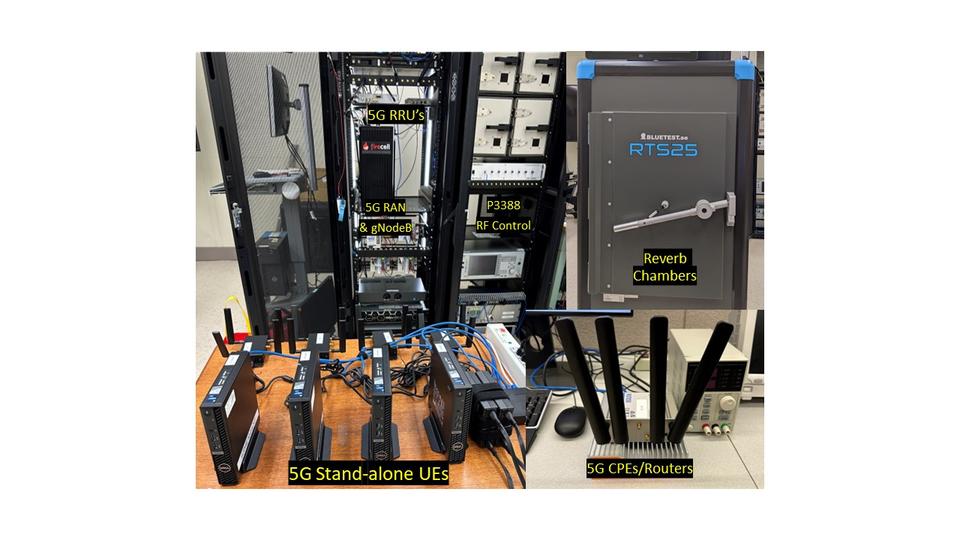Summary
The NIST 5G Industrial Wireless Testbed is a pioneering project designed to reshape industrial connectivity by deploying and evaluating 5th generation (5G) wireless technology in an industrial context. Focused on addressing the demands of Industry 4.0, this initiative incorporates a cyber-physical component, showcasing the symbiotic integration of digital and physical systems. Objectives include evaluating 5G performance, enabling low-latency applications, enhancing connectivity, and assessing security and reliability. The testbed introduces wireless aggressors to simulate real-world interference and path loss scenarios, ensuring the robustness of the 5G network. Key components involve deploying a cutting-edge 5G infrastructure, integrating industrial IoT devices, implementing edge computing solutions, and establishing robust resiliency protocols. Expected outcomes encompass quantifiable performance metrics, demonstrations of 5G applications, standards input, best practices, and insights for industry adoption. This project provides a transformative era of industrial connectivity, emphasizing the unique fusion of 5G technology and cyber-physical systems to propel the advancement and adoption of wireless communications technology as a principal mode of communications for industrial applications.
Description

The NIST 5G Industrial Wireless Testbed project aims to revolutionize industrial connectivity by deploying and evaluating the capabilities of 5th generation (5G) wireless technology within an industrial setting. This initiative responds to the emerging demand for ultra-reliable, low-latency communication networks that can support diverse applications crucial to modern industrial systems, with a specific focus on integrating and evaluating the cyber-physical component.
Objectives:
- Evaluate 5G Performance: Assess the performance of 5G networks in an industrial environment, focusing on factors such as data speed, latency, and reliability.
- Enable Low-Latency Applications: Investigate the potential of 5G to facilitate real-time communication for mission-critical applications, such as industrial automation, robotics, and remotely controlled systems.
- Enhance Connectivity: Improve wireless connectivity within the industrial ecosystem by deploying 5G infrastructure to overcome traditional limitations and bottlenecks.
- Security and Reliability: Assess the security features of 5G networks and evaluate their resilience in industrial settings to ensure the integrity and availability of critical data.
- Integration with IoT: Explore seamless integration with the Internet of Things (IoT) devices to create a comprehensive ecosystem that enhances automation, monitoring, and control processes.
- Wireless Aggressors: Integrate wireless aggressors into the testbed to simulate real-world interference and path loss scenarios and assess the robustness of the industrial 5G network in the presence of potential degradation factors.
- Cyber-Physical Component: Introduce a cyber-physical component to the testbed such as collaborative robotics and remote manipulator control, emphasizing the integration of digital and physical systems. This component will demonstrate the symbiotic relationship between the virtual and physical worlds connected by 5G wireless technology.
Key Components:
- 5G Infrastructure: Deploy a state-of-the-art 5G network infrastructure, including base stations, antennas, and core network components, to provide comprehensive coverage within the industrial facility.
- Industrial IoT Devices: Integrate a variety of industrial IoT devices, sensors, and actuators to demonstrate the potential for enhanced automation and data-driven decision-making.
- Edge Computing Platforms: Implement edge computing solutions to process data closer to its source, reducing latency and enabling faster response times for critical applications.
Expected Outcomes:
- Performance Metrics: Provide quantifiable data on the performance of the 5G network in an industrial environment, showcasing improvements in speed, reliability, and latency, even in the presence of wireless aggressors, with a focus on the cyber-physical integration.
- Use Case Demonstrations: Showcase practical applications of 5G technology in industrial settings through live demonstrations, emphasizing its impact on efficiency, productivity, and safety under realistic interference scenarios, while highlighting the cyber-physical synergy.
- Best Practices: Establish best practices for implementing and optimizing 5G networks in industrial scenarios, considering the challenges posed by wireless aggressors and incorporating insights from the cyber-physical integration.
- Industry Adoption: Encourage the adoption of 5G technology within the industrial sector by disseminating findings, collaborating with stakeholders, and promoting the benefits of enhanced connectivity, including resilience against wireless aggressors and the transformative power of wireless cyber-physical integration.

